Shevlin Sebastian's Blog, page 79
January 12, 2017
All About Mobile Towers
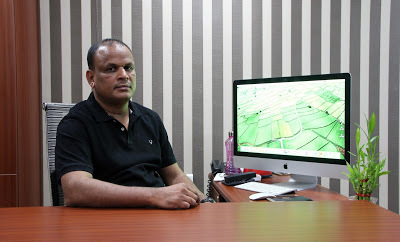
 Santhosh Eapen, whose company maintains 8500 mobile towers in Kerala, Tamil Nadu and Karnataka, talks about the pluses and minuses
Santhosh Eapen, whose company maintains 8500 mobile towers in Kerala, Tamil Nadu and Karnataka, talks about the pluses and minusesPhoto of Santhosh Eapen by Albin Mathew
By Shevlin Sebastian
The question is asked so many times to Santosh Eapen that he is ready with the answer before the query is over. So here is the question: Are mobile towers a radiation hazard?
“For every 15 kms of this city [Kochi], a technician is working on a tower,” says Santhosh, the managing director of Unitac Energy Solutions India Pvt Ltd. “He goes to the tower many times each day. There is a 300 sq. ft. room, where the batteries and other equipment are located. They do preventive maintenance. And in 16 years, nobody has suffered from the effects of radiation. My first employee, Binter, is still working for the company and has no health problems whatsoever.”
He gives another example: in remote areas in Karnataka, many eagles and monkeys, bees in honeycombs live on these towers. “But they are all alive and kicking,” says Santhosh. “Nothing has happened to them.” (At the same time, there is also no doubt, that if you use any device, like a mobile or radio, or at the tower there is radiation.)
His company maintains 8500 towers in Kerala, Tamil Nadu and Karnataka. “Next April, we will have another 2000 more,” says Santhosh. “A tower has different heights. If it is on a rooftop, it will have a height of 9-27 feet. If it is at ground-level, it will reach a height of 120-150 feet.”
Of course, as is well known, when we speak into a mobile phone, it is picked up by the receiver and the voice is distributed through several towers before it reaches the person called. “But it just takes seconds,” says Santhosh. “At a time, a tower can handle 52 calls.”
The biggest problem is during the rainy season when there is a shortage of power because of lightning strikes. “When the tower ceases to work you will get the message that the caller is out of range,” says Santhosh.
But another reason for the interrupted coverage is the low number of towers.Kerala, with an area of 40,000 sq kms, has 12,000 towers. “For a population of 3.25 crore, of which 70 per cent have mobile phones, we need a lot more towers,” he says. “But then the fears of radiation among the public is preventing us from setting up more.”
Santhosh, who grew up in Kochi, went to the United Arab Emirates and worked there for a few years. But owing to his ageing parents, living alone, he returned in 1998. His first business was running a car agency. Then, in 2000, mobile service provider Airtel came to Kerala. “As a supplier of vehicles, I began interacting with Airtel managers,” says Santhosh. “Slowly, they began to entrust technical works to me. In short, I was the right person at the right time.”
He has an office strength of 1100 and also runs a successful real estate business called Unitach Villas and Apartments. They have six ongoing projects: five in Kochi and one at Tripunithara.
Asked the secret of his success, Santhosh says, “God has to smile at you. Of course, you also need hard work and dedication and a very good team.”
But for his team there are no fixed working hours. You work as and when is it required. “That is because we are in the essential-services category,” he says. “Plus, I offer merit-based promotion. Staffers, who joined at the start, have become directors of the company.”
(The New Indian Express, Kochi and Thiruvananthapuram)
Published on January 12, 2017 00:20
January 10, 2017
To Look Good At All Times

 The US-based make-up expert Cecilia Muench talks about the various ways to look good, while on a recent visit to Kochi
The US-based make-up expert Cecilia Muench talks about the various ways to look good, while on a recent visit to KochiPhoto of Cecilia Muench by Albin Mathew; Jennifer Lopez
By Shevlin Sebastian
Make-up artiste Cecilia Muench had gone to the washroom, during the 'Make-up Show', at Orlando, USA, a couple of years ago. When she returned, her daughter told her, “Somebody from India was inquiring about you. He said he would come back.”
Cecilia was intrigued. She wondered whether the Indian would come back. Thankfully, he did. Salmon Mathew, a Florida-based businessman, is a partner in a make-up company with Mollywood's veteran make-up expert Pattanam Rasheed.
Salmon invited Cecilia to come to Kerala to give a workshop on make-up. She accepted, but it took two years, before she was able to come to Kochi recently.
And, as promised, she held a one-day workshop on make-up, organised by the Pattanam Designory, for more than 400 aspiring artistes.
In a surprise, Cecilia says, that she is a fan of Indian make-up. “It has a trademark, which is the liner around the eyes,” she says. “This is known around the world. When you see eyes that are sophisticated and shine a lot, you know they are Indian eyes.”
In Kochi, Cecilia gave lessons on how to do make-up for those who are exposed to 4K technology in TV and cinema. “4K has four times more pixels than high-definition images,” she says. “If you put too much foundation, it shows like plastic skin on the screen. You have to put the make-up in a sheer and natural way, and blend it well.”
Rasheed says that Cecilia's classes were an eye-opener. “We knew only the older techniques,” he says. “But now the students understood how to do make-up in the era of digital photography. Most of the students gained a lot from the interaction. And they were impressed by Cecilia’s sincerity and passion.”
According to Cecilia, make-up is applied according to the personality and style of the person. “There are seven different styles for women: Dramatic, Creative, Sensual, Natural, Formal, Casual and Classic,” she says.
She gives examples. “Dramatic women use dark lips and dark eyes,” she says. “A natural woman will wear light lipstick and shadow on the eyes. An elegant woman will have dark lips and light eyes.”
However, in public functions, it could be a good idea to know the type of lights that are used. “The lights add to the colour,” she says. “In yellow light, if you put yellow or red lipstick, the lips will have an orange colour. If it is a white light, which is actually bluish in colour, red lipstick will look purple.”
Regarding wedding-up, Cecilia insists that one should respect the personality and style of the bride. “You have to ask her what she wants,” she says. “She is the star, the queen of the day. If she does not want a loud make-up, mute it down. It has to be a make-up that represents her style. She has to feel good. After all, it is the most important day of her life.”
When asked which international celebrity wears the best make-up Cecilia has no hesitation to name Jennifer Lopez, the top-selling singer and actor. “Sometimes, she looks very sophisticated, and at other times she is dramatic,” says Cecilia. “She is a chameleon, and one of the best.”
Interestingly, make-up plays a vital role when you grow older. “When you age, the skin loses colour,” she says. “Young girls have rosy cheeks, glowing skin and wide eyes. But, because of ageing, the eyes get yellow, and look pale and sad. The skin becomes flaccid and the expression on your face gets harder. It makes you look angry or harsh.”
However, the appropriate lipstick and eye-liner and blush can make all the difference. “Make-up is the best way to fight age,” says Cecilia.
(The New Indian Express, Kochi and Thiruvananthapuram)
Published on January 10, 2017 22:30
January 9, 2017
A Taste Of Kolkata In Kochi
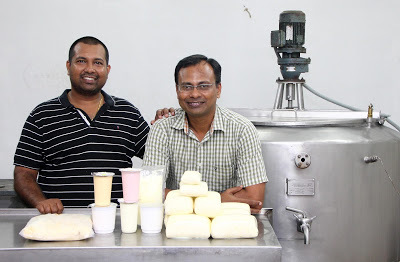
 The Sarkar brothers, Amit and Sourabh, make authentic North Indian paneer, as well as popular Bengali sweets like rosogollas and sandesh
The Sarkar brothers, Amit and Sourabh, make authentic North Indian paneer, as well as popular Bengali sweets like rosogollas and sandesh Photo of the Sarkars by Albin Mathew
By Shevlin Sebastian
When Amit Sarkar and his wife Neelima would come to Kochi, from Mumbai, to spend their annual vacation, she would say, “There are no good vegetarian restaurants in Kochi. I miss eating paneer.”
Later, when he reached a dead-end in his job, Neelima said, “Why don’t you start a business of making paneer in Kochi?” Amit, a Bengali, grew up in Kochi. Intrigued, he did research and realised that there is a market for authentic North Indian paneer. To arm himself further, he did a six-month internship course on dairy products at Amul, Anand.
In February, 2013, he started Sarkars Dairy Tech with his younger brother Sourabh. Today, the company makes one tonne of paneer every day and sells it to five-star hotels in Kerala, Karnataka and Tamil Nadu.
The milk comes every day at 3 a.m. in a truck from Hosur, Karnataka. Thereafter, 36 lab tests are done to check whether the milk is acidic or not, good or bad. Once it is okayed, it is put into a pasteuriser which has two chambers. In one, water is heated up. The steam that is generated heats up the milk which is in an adjacent chamber. So the milk is never directly heated. That is how the flavour of the milk is retained.
“The cow milk that we get has a fat content of 4 per cent,” says Amit. “But to get good paneer, you need 6.5 per cent.” This is achieved through a milk standardisation process, as well as a natural coagulant, which has been imported from Italy. “I came across it while attending a dairy fest in Delhi,” says Amit.
Soon, paneer chunks are formed. Thereafter it is placed in hoops, which is a type of tray. These blocks of paneer are cut into 200 grams, half a kilo and one kilo packets and neatly packed.
“The paneer is then transported in an insulated truck, where the temperature is kept at 4 degrees centigrade,” says Amit. “This is mandatory. Hotels do a temperature check before they accept the paneer.”
As their business develops steadily, the brothers have branched out further. They have opened a Bengali sweet retail shop called Bikash Babu Sweets at Kochi. “We are selling sweets like rosogollas, misthi doi (sweet curd), sandesh, malai pakeeza, khaju and jaggery sandesh,” says Sourabh. “This is more of a passion, rather than a business. We are trying to bring the Kolkata taste to Kerala.”
And on a sunny evening, there are several customers at their outlet. Amit points at an empty tray, and says, “300 samosas have already been sold.”
Both the Sarkar brothers give bright smiles. Their Jamshedpur-based father PK Sarkar came to Kochi, on a work-related purpose, in 1979, and loved the place. Soon, he settled down in the coastal city. “We call ourselves the Mallu-Bong Sarkars,” says Amit.
(Sunday Magazine, The New Indian Express, South India and Delhi)
Published on January 09, 2017 21:26
A Unique Perspective
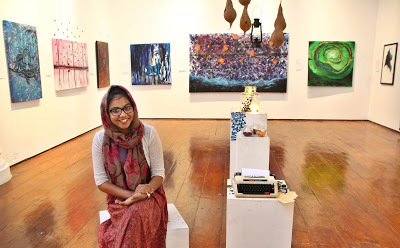
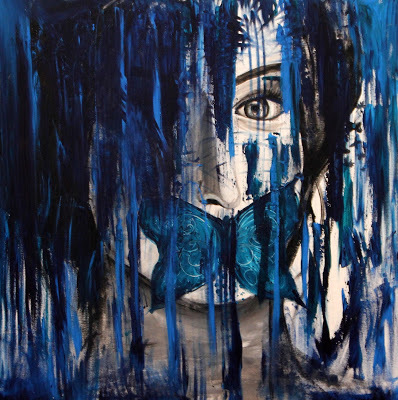 Fathima Hakkim makes an impressive debut with her 'Aurora' show at the Durbar Hall art gallery
Fathima Hakkim makes an impressive debut with her 'Aurora' show at the Durbar Hall art galleryPhoto of Fathima Hakkim by Albin Mathew
By Shevlin Sebastian One day, Rashida Begum (name changed) told the artist Fathima Hakkim that she had a secret to reveal. Childhood friends, while growing up in Kollam, Rashida spoke about being molested by her uncle when she was five years old. “My uncle told me that if I opened my mouth, my parents would get hurt,” said Rashida. “I kept quiet for 18 years. It made me a very lonely person. I was scared to talk to anybody.” A shocked Fathima could not go to sleep that night. Instead, she drew a painting of a girl, with dishevelled hair falling all over her face, but with one troubled eye revealed. On her lip is a butterfly. This is very similar to the famous 'Silence of the Lambs' film poster, which has a butterfly resting on heroine Jodie Foster's mouth. “I was deeply upset by Rashida's experience,” says Fathima. “Many women go through similar experiences.” This unnamed painting, an acrylic on canvas, was on display at Fathima's 'Aurora' exhibition, which was held recently at the Durbar Hall art gallery, Kochi. There are 26 other paintings: watercolours as well as acrylic on canvas. There is one where a figure of a naked girl, arms outstretched in agony, is invaded by several small fish. And this image was prompted by an incident at a bus stop, at Kollam. “A man, in his thirties, kept staring at me for a long time,” says Fathima. “He had eyes like a fish: unblinking, cold and lecherous. I felt frustrated. Later, I made a canvas where I drew several fishes which ring my body like the eyes of so many men.” Other themes included the complicated man-woman relationship, the mocking comments which are reserved for fat woman, the joy of being in love and the beauty of the 'Aurora' constellation of stars. She also has installation works, like paper boats hanging from the ceiling on thin, white strings, an old 'Brother' typewriter, yellow Indian postcards, cumin seed candy and circassian seeds. “I wanted to recreate everything from the 1990s, since I am a Nineties child,” she says. “But all this has gone out of fashion.” A trained architect, this is the 24-year-old's first solo exhibition. And it has not been an easy journey for her. Members of the Muslim community questioned her need to have a public exhibition and show her face. “They said that my face is irrelevant,” she says. “I don't agree with that. My face, my personality and my name makes me an unique person.” Her parents, homeopathic doctor Abdul Hakkim and mother, Haneesa, an economics professor dropped their opposition when they saw the exhibition. “They understood my passion for art,” says Fathima.
This passion had begun in her childhood. An introverted child, who suffered from dyslexia, she would sit and draw all the time. “Anything that happened around me, I could paint it and get away from it,” she says.
The end result is a bright debut for a shining talent.
(Sunday Magazine, The New Indian Express, South India and Delhi)
Published on January 09, 2017 00:38
January 6, 2017
An Encounter With Om Puri
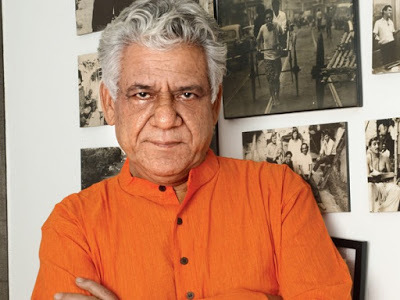 by Shevlin Sebastian
by Shevlin SebastianOn a moonlit night on the beach at Kovalam, some years ago, actor Om Puri was dressed casually in a bright orange T-shirt and khaki Bermuda shorts. He had come to attend a literary festival where his wife Nandita read extracts from her biography of him.
Om was at ease, as guests milled around him. Seeing his down-to-earth manner it was difficult to believe that he was, as veteran American film critic Michael Sragow said, ‘the greatest living actor today.’
A day later, at the poolside of the Taj Green Cove, smoking a cigarette with relish, Om talked at length about his life.
In the early seventies, at the Khalsa College, in Patiala, during a drama competition, Om was acting in a Punjabi play called ‘Anhonee’. The judges were Harpal and Nina Tiwana from the National School of Drama (NSD). “They gave me the best actor award,” says Om.
The Tiwanas invited him to join their troupe, the Punjab Kala Manch. But he did not have any free time. During the day he worked as a lab assistant in the college, while he attended classes in the evening. Harpal said, “How much do you get paid for your job?”
When Om replied that his salary was Rs 125, Harpal said he would give Rs 150. Om joined at once. “Acting was my passion, so I had no problem in saying yes,” he says.
Om remained with the troupe for three years, acting in plays all over Punjab. Thereafter, following a stint at the NSD at Delhi, and the Film and Television Institute of India at Pune, Om moved to Mumbai in 1976 and played bit roles, before Govind Nihalini cast him in ‘Aakrosh’ in 1981. Then came Satyajit Ray’s ‘Sadgati’, before he got the role of Sub-Inspector Anant Velankar in ‘Ardh Satya’ in 1983.
“It was the biggest turning point in my life,” he says. “When I read the script by [Marathi playwright] Vijay Tendulkar, I said, ‘Wow’. I could totally identify with the character: the political interference, the pervasive corruption, and the way it damages the soul.”
When the film was released it became a hit. Thereafter, he acted in several movies. Looking back, Om said, "For me, the real hard-hitting cinema was between the 1980s and 1990s where Shyam Benegal, Govind Nihalani, Basu Chatterjee, Mrinal Sen and Gulzar made some remarkable films.” he says.
Om’s next big break came when he was cast as Hasari Pal, the rickshaw-puller in the Roland Joffe film, ‘City of Joy’ in 1990. Following the release, he received worldwide critical acclaim. “It opened a big window of opportunity for me in the West,” he said. Om acted in several Western films, including ‘My Son the Fanatic’, ‘East is East,’ 'Parole Officer' and ‘Wolf’.
Along the way, Om has won numerous awards, like the Padma Shree, the Karlovy Vary award and the Order of the British Empire in 2004. His filmography runs to over 200 films.
More recently, he featured in Bollywood films like 'Ghayal Once Again' and 'Mirzya'. His distinct baritone was used as the voice of black panther Bagheera in the Hindi version of the Hollywood film, 'The Jungle Book'.
Unfortunately, on the personal front, things were not hunky-dory. In 2013, Nandita filed a domestic violence case against him. They separated, leaving him with only visitation rights to their son, Ishaan.
Asked to explain his philosophy of life he said, “The other day a dear friend of mine passed away. As I stared at his body, a thought came to me: ‘He has two hands, two eyes, two legs, a nose, a brain, and hair. He has everything, and yet something was missing. Why is he not moving? Why is he not talking?'”
Om became silent and stared into the distance. Then he finally said, “The spirit is missing. What is life? It is so fragile. We are at the mercy of a power in the universe. So let us stop boasting, and become humble.”
(The New Indian Express, Kochi and Thiruvananthapuram)
Published on January 06, 2017 22:43
January 4, 2017
Up Above The World So High
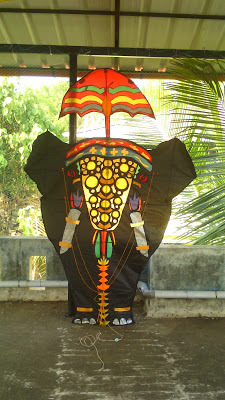
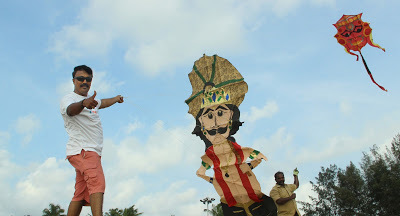 Kite lover Rajesh Nair has made a kite in the form of a caparisoned elephant, with an umbrella over its head. It will be flown at upcoming kite festivals
Kite lover Rajesh Nair has made a kite in the form of a caparisoned elephant, with an umbrella over its head. It will be flown at upcoming kite festivalsPhoto of Rajesh Nair by Melton Antony
By Shevlin Sebastian
Kite lover Rajesh Nair has a look of anticipation on his face. At his home, in Aluva, a 14 ft. high kite is all set to soar into the skies. It is a caparisoned elephant, with an umbrella over its head, the enduring symbol of the state's premier festival, the Thrissur Pooram.
Rajesh will be flying it in four upcoming kite festivals: in Ahmedabad (January 8-12), Hyderabad (Jan 13 -16), Panjim (Jan 17-19), and Belgavi in Karnataka (January 20-22). “During these festivals, we are encouraged to showcase our heritage, as well as traditional art forms,” says Rajesh.
In fact, Rajesh has always highlighted Kerala culture in his kite designs. During a festival in Malaysia, Rajesh flew a kite resembling a theyyam dancer. The media was so enthralled that the 'Borneo Post' published a photograph of Rajesh flying the kite on the front page.
On another occasion, he flew another kite designed as Mahabali, the benevolent Asura king. So, you could see the crown, along with the black moustache, a protruding paunch and the umbrella.
But, interestingly, none of his kites are made of paper. Instead, he uses a nylon fabric called ripstop. “It is used in the making of parachutes, and does not tear easily,” says Rajesh. “If there is a tear it does not spread. It is used extensively in the kiting community.”
However, ripstop is not available in India. Rajesh imports it from China, at Rs 350 per metre. The price can go up, depending on the colours and thickness. “I always try to use lighter material so that the agility and maneuverability are easier,” says Rajesh.
After he has secured the fabric, Rajesh does the drawings. Then he cuts the cloth according to the lines of the drawing. Then it is sewn leaving space for pockets to be stitched where the bamboo sticks are to be inserted.
But before that, the bamboo has to be treated carefully. “Every bamboo, when it is cut, is wet,” says Rajesh. “So you need to dry it in the sun. Then it turns into a yellow colour. So, termite oil is applied. It has two benefits. The termites will keep away, and the bamboo will bend beyond 90 degrees, without snapping.”
Since the kite is made of cloth, the wind does not pass through. “Therefore, depending on the wind, the kite could weigh between 150 and 300 kgs in the air,” says Rajesh. “The most comfortable wind speed is 10 to 15 kms per hour.”
Surprisingly, on the ground, when the kite is folded, it can be placed inside a suitcase, and weigh only three kilos.
To follow his passion, Rajesh works nights and on the weekends, following his day-job as a consultant on corporate social responsibility for many companies.
Not surprisingly, his love for kites began in his childhood, at Kozhikode. His father taught him how to make his first kite. And, thereafter, his obsession deepened. “When you fly kites, you experience a sense of freedom,” says Rajesh. “It seems as if I am also flying in the sky along with my kite.”
Over the years, a desire to spread the love of kites arose in him. So, in 2010, Rajesh set up the KiteLife Foundation. Thereafter, he has held numerous workshops for children and adults alike, all over Kerala. “The centre of kite-flying is in Ahmedabad,” he says. “But I also want Kerala to develop a kite-flying culture.”
(The New Indian Express, Kochi and Thiriuvananthapuram)
Published on January 04, 2017 21:30
January 3, 2017
Almost Getting Burnt
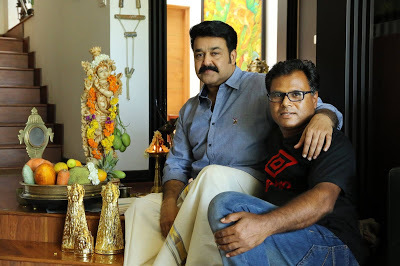
 COLUMN: LOCATION DIARY
COLUMN: LOCATION DIARYVeteran still photographer Paul Bathery talks about his experiences in the films, 'Vesham', 'Bhramaram', 'Kaazcha' and 'Calcutta News'
Photos: Mohanlal with Paul Bathery
By Shevlin Sebastian
The funeral pyre was placed at the top of a hill in Pokkunnu, near Kozhikode. The shoot was for the film, 'Vesham' (2004). Mammooty, as the hero, was supposed to light it. A group of people surrounded the pyre. Veteran still photographer Paul Bathery was at one side.Soon, petrol was poured into the middle of the wooden pyre. Thereafter, it was lit up.
“Nobody had realised that, because of the slope, some of the petrol had flowed downwards,” says Paul. “Soon, the fire came rushing at us, at great speed.” Paul jumped away at the last moment, but in the process suffered bruises and one of his camera lenses got damaged. In the end, it cost him Rs 15,000 to replace it.
Like in 'Vesham', there was a close shave in Blessey's 'Bhramaram' (2009). The shoot was in the high ranges, beyond Munnar. Paul was in a jeep that was just behind Mohanlal, who played the hero. “I noticed that the jeep in front was going downwards at a very high speed, even though it was a steep slope,” says Paul.
After a while, the jeep came to a stop. “It was then that we came to know from the driver that there was a brake-fail,” says Paul. “Somehow, he managed to bring the jeep to a safe stop. We were very lucky that a major accident, involving a superstar, did not take place.”
But an accident did take place during the shoot of 'Kaazcha' (2009) at Kuttanad. At 11 p.m., pack-up time was announced. “Most of the crew thought they would have their dinner in the privacy of their rooms,” says Paul. “So they all rushed to the boat, with their food containers.”
When Paul saw the presence of so many people, he decided to go later. Meanwhile, the boatman set out, but, within seconds, the boat capsized, and everybody fell into the water. “Thankfully, it was not very far from the shore, so it was not very deep,” says Paul. “However, I could see many food containers floating on the water.”
In the Hindi film, 'Pa Pal Dil Ke Ssaat' (2009), which starred former cricketer Ajay Jadeja, Paul could no longer escape being in an accident himself. At the Kumarakom shoot, Paul got onto a skiff, to get a better shot. “But as I concentrated on taking a good shot of Ajay, I slipped and fell into the water,” he says. “A 50mm lens got wet. Again, I had to spend Rs 15,000 for a new one.”
Meanwhile, Ajay had taken a shot of Paul in the water. “Later, Ajay showed it to me, and we had a good laugh over it,” he says.
Paul had a completely different experience on the sets of 'Calcutta News' (2008). The shoot was in Sonagachi, the red-light district of Kolkata. When the crew first arrived, the girls looked at them with wariness. “But when they realised that we were shooting a film, they became very friendly,” says Paul.
And they told their stories. One beautiful girl, who worked as a junior artiste in the film, said that her father, who had been in the Army, died when she was young. She has no idea where her mother was. Seeing no option, she entered the flesh trade. “She asked us crew members whether we could take her to Kerala,” says Paul. “She was willing to work as a maid, so that she could get away. But we felt bad that we could not help her.”
(The New Indian Express, Kochi, Thiruvananthapuram and Kozhikode)
Published on January 03, 2017 23:11
At Home, Away From Home
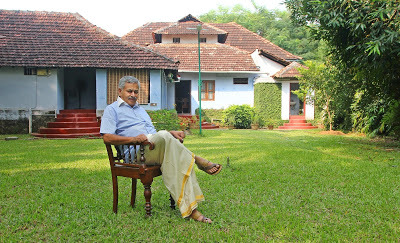
 The Kandath Tharavad homestay at Palakkad, Kerala, is a place to unwind and enjoy the company of the owner
The Kandath Tharavad homestay at Palakkad, Kerala, is a place to unwind and enjoy the company of the ownerPhotos: Kandath owner K.S. Bhagwaldas; Prithviraj and Supriya
By Shevlin Sebastian
At the Kandath Tharavad homestay in Palakkad, Kerala, Roy Peterson, 81, a retired psychologist from New York, leans back in his chair and stares into the distance. It is a tranquil environment: a rolling green lawn, leafy trees, the buzz of bees, and the occasional cawing of a crow. Added to this is a sense of history.
The house is 250 years old. Red oxide floors and wooden ceilings, doors, beds and windows, as well as an inner courtyard. But, on this particular November morning, Roy is looking glum. An English newspaper, lying on a low table in front of him, gives the hint: 'Win for Donald Trump'.
“Yes, I am deeply disappointed,” says Roy. Smiling genially is Kandath owner, K.S. Bhagwaldas, 66. He has been running the homestay for 16 years now. His guests come mainly from Britain, France, Australia, Belgium, Switzerland and Japan.
In fact, Toshio Akai, a humanities professor at Kobe Gakuin University, has been coming for the past seven years. Asked about the charms of the homestay, Akai says, “Bhagwaldas's hospitality has introduced me to the slowly flowing time of rural Kerala, in which my body and spirit are able to have a profound rest. I relish the chance to do nothing. It allows me to be myself.”
Guests get immersed in the Kerala culture by visiting a basket-weaving village and the three-century old Palakkad Fort, going fishing and trekking, apart from day trips to the famous Lord Krishna temple at Guruvayur and the Kerala Kalamandalam arts centre. “The big difference, from other homestays, is that I accompany the guests,” says Bhagwaldas. “And since I have spent more than 15 years in the USA, I am able to establish a wavelength easily.”
Expectedly, the food is pure Kerala fare: appams, dosas, jackfruit, tapioca, rice and fish-curry meals. And, on some mornings, Bhagwaldas takes them to a nearby village called Ramassery. “It is famous for making a special type of idli,” says Bhagwaldas. “So, we go with tablecloth, napkins and glasses and lay it out and have breakfast with the locals.”
All this fun comes for a daily tariff, ranging from Rs 7,600 to Rs 12,600, depending upon the size of the room.
The Kandath Tharavad hit the media spotlight when it hosted the wedding of Mollywood superstar Prithviraj and Supriya Menon on April 25, 2011. “They were looking for a quiet place, and it was booked by Prithviraj's father-in-law, who lives in Palakkad,” says Bhagwaldas. “Prithviraj arrived with his immediate family consisting of 50 people. It was a very private ceremony.”
Meanwhile, most of the money that Bhagwaldas earns is plowed back into the maintenance of the house. It belonged to his great-great-grandfather Kuppevelan, an agriculturist. “Since it is a family inheritance, I have to ensure that I look after it well, for future generations,” says this father of two children.
(Sunday Magazine, The New Indian Express, South India and Delhi)
Published on January 03, 2017 00:05
January 1, 2017
Checking Out The Coast
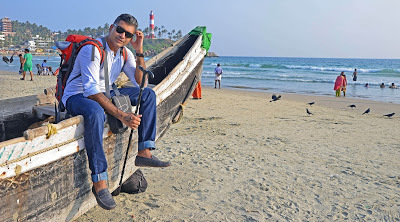 On January 1, travel writer Thommen Jose embarked on a 590 km walk, along the coast of Kerala, to study the effects of global warming
On January 1, travel writer Thommen Jose embarked on a 590 km walk, along the coast of Kerala, to study the effects of global warmingPhoto of Thommen Jose by BP Deepu
By Shevlin Sebastian
On a weekday afternoon, the Delhi-based travel writer Thommen Jose stood on the banks of the Yamuna River and stared at the water. For some reason, he thought of sea erosion. And then, suddenly, an image from the past came swirling up. It was about his 12 km walk, along the Kerala coastline, in 2001, during the time he was doing his post-graduation in journalism.
“I walked from Shanmugham to Kovalam,” says Thommen, while on a recent visit to Kochi. “I followed the coastline. It took me the better part of a day. Along the way I interacted with the local people. At Kovalam I went out on a boat in the high seas, with a group of fishermen. We caught fish using nets and smoked a cheroot.”
A few months later, Thommen did the walk again. “I grew fond of the journey,” he says. “But I got a shock. Because when I retraced the path, I saw that large slices of the coastline had been eaten away.”
These images sparked an idea in Thommen. He decided to do a walk from one end of Kerala’s coastline, to the other, a distance of 590 kms. With that aim in mind, Thommen flew to Kochi to do research.
He met up with the Minister for Fisheries and Harbour Engineering J Mercykutty Amma, who gave him disturbing news.
“She said that 50 per cent of the coastline is artificial,” says Thommen. “That means, at these stretches, they have built sea walls, and groynes (a low wall which juts out into the sea, in order to break the tide, and reduce the ferocity of the lashing).”
The future is grim. “According to global warming researchers, by 2040, we can sail across the Arctic Circle in a boat because all the ice floes and glaciers would have melted,” says Thommen. “This means that the water levels will rise up, and many coastal cities, all over the world, including those in Kerala, will go underwater.”
To create awareness about the environmental damage, Thommen plans to write a book. But when he approached major book publishers, they only wanted a positive story about his walk. “But that would not be a true account,” he says.
According to plan, Thommen set out, on January 1, from Kollamkode. He has taken along a camera, laptop, books and clothes. Every day, he is planning to aggregate 15 kms. “I will not be walking continuously,” says Thommen. “Along the way I will stop and hear stories from the people about the impact of global warming.”
And these will be used in his book. Thommen has spent the best part of the past decade travelling in many parts of India and the world. His previous books were on Agra and Chhattisgarh.
“Travel opens your mind and heart,” he says. “It also makes you happy.”
(Sunday Magazine, The New Indian Express, South India and Delhi)
Published on January 01, 2017 20:22
December 21, 2016
Picking Up A Crocodile
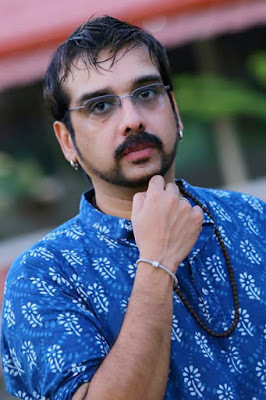
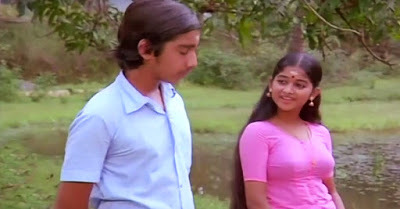 COLUMN: LOCATION DIARY
COLUMN: LOCATION DIARY Actor Vineeth talks about his experiences in the films, 'Nakhakshathangal', 'Kadhal Desam' and 'Sakthi'
Photos: Vineeth; Vineeth and Monisha Unni in the film, 'Nakhakshathangal',
By Shevlin Sebastian
In the film, 'Nakhakshathangal' (1986), Vineeth, who plays a 16-year-old boy Ramu meets an equally young Gowri (played by the late Monisha Unni) at the home of a lawyer.
Then she takes him to the dining room to have a cup of tea. The chief cook is played by Kuthiravattam Pappu. “As soon as he comes in, he speaks in a mocking voice and tells her that her visitors are supposed to sit in the kitchen, and not in the dining room,” says Vineeth. “But the way he spoke, in his nasal voice and quaint mannerisms, I found it funny.”
Vineeth would start laughing and, invariably, Monisha would also end up joining him. Every time, the scene had to be shot, both would laugh. “[Director] Hariharan Sir showed a lot of patience,” says Vineeth. “But soon Pappu began complaining, because it was affecting his timing and spontaneity.”
Finally Hariharan lost his cool. Abruptly, he got up and walked out of the house in Shoranur. The crew fell silent. “Both Monisha and I were in shock,” says Vineeth.
The assistant director remonstrated with them. “What is happening to you two?” he said.
After an hour, Hariharan returned. “This time, somehow, we managed to control our laughter, and the scene was shot, to our relief,” says Vineeth. “This was an experience that I will never forget.”
Another experience that Vineeth has not forgotten took place on the sets of the Tamil film, 'Kadhal Desam'. The shooting of the AR Rahman hit song, ‘Mustafa, Mustafa’ was taking place at Presidency College, in Chennai, which was adjacent to a slum. There were several dancers as well as junior artistes.
However, one evening, some young men, armed with knives, came barging into the set, led by a ten-year-old. “They showered abuses on us,” says Vineeth. “One of them shouted, ‘Where the hell is the girl? Who does she think she is?’”
Apparently, the boy had been going around selling peanuts. According to the boy's version, one of the dancers said, “You scoundrel, get out.” Anyway, in the chaos, the girl was spirited away in a car. Finally, the crew members intervened, apologies were given, and the mollified youths left.
Vineeth had a completely different experience during the shoot of the Tamil film, 'Sakthi' (1997). For a particular sequence, at a stream in Pollachi, Vineeth was supposed to intervene in a fight between an elephant and a crocodile.
“Kanal Kannan, a top fight master, told me not to worry,” says Vineeth.
Kannan's asssistant Peter Hein [of 'Pullimurugan' fame] showed me how to pick up the crocodile and come out of the water.”
To do that, an iron wire was tied around its stomach. The mouth, with the protruding teeth, was also closed up with a wire. The crocodile was quiet. He was floating in the water.
Vineeth went and touched it, in order to get over his fear. “It did not react at all,” says Vineeth. “But his eyes kept winking.”
The shoot began. Vineeth ran into the water, called out the name of God, picked up the crocodile, ran back to the bank and flung it down. “There were five takes,” says Vineeth. “Throughout, the crocodile remained quiet.” The shoot was completed on time.
Thereafter, the crew took a break. Following that, the crocodile became extremely violent. “Nobody could go near it,” says Vineeth. “Thank God, the shoot was over. Otherwise, it would have been very difficult.”
(The New Indian Express, Kochi, Thiruvananthapuram and Kozhikode)
Published on December 21, 2016 21:34



